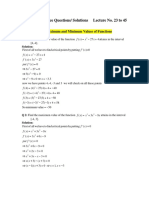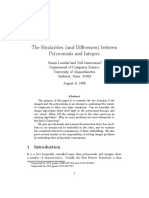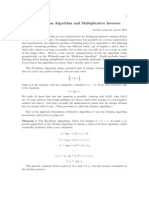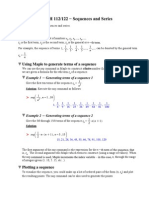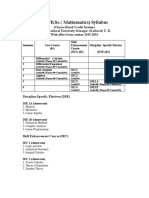Practical Guide 05 Improper Integrals
Uploaded by
EmilPractical Guide 05 Improper Integrals
Uploaded by
Emil0.
1 Practical Guide - Improper Integrals
We should start with some argument about improper integrals. Why do we consider such a problem. Quite simple
question.
Consider a Riemann integrable function ) : (c, ,) R , actually integrable on any subinterval [a, /] (c, ,).
So it makes sense to compute (measure)
b
_
o
)(r)dr
no|
= H(a, /)
The notation is of no importance, just shows the integral depends on a and / as two parameters.
Then ask what happens if a c and / ,, that is
lim
o!o,b!o
b
_
o
)(r)dr
no|
=
o
_
o
)(r)dr
A natural question comes out, why bother about taking limits instead of directly computing the integral
o
_
o
)(r)dr
Simply because :
1) ) may not be Riemann integrable on (c, ,) or
2) c = or , = + (quite unusual situation ! ) or
3) ) is Riemann integrable on (c, ,) , but the integral is hard to compute
We will consider only a very simple case: ) is continuous on (c, ,)
Therefore ) has antiderivatives, say 1 : (c, ,) R , derivable and 1
0
(r) = )(r)
Consequently
b
_
o
)(r)dr = 1(/) 1(a)
and
o
_
o
)(r)dr
no|
= lim
o!o,b!o
b
_
o
)(r)dr = lim
o!o,b!o
[1(/) 1(a)] = lim
b%o
1(/) lim
o&o
1(a)
It is quite easy to realize that such an integral makes sense only if both limits exist and are nite. We state
now a denition.
Denition. Let ) : (c, ,) R , be a continuous function on (c, ,) and 1
0
= ) some antiderivative. Call
"improper" integral the following
o
_
o
)(r)dr
no|
= lim
o!o,b!o
b
_
o
)(r)dr = lim
b%o
1(/) lim
o&o
1(a)
The improper integral is called
i) convergent if both limits exist and are nite
ii) divergent otherwise
we may use the simplied notation
o
_
o
)(r)dr = 1(r)[
o
o
= lim
r%o
1(r) lim
r&o
1(r)
1
Comment. This seems to be just a simple problem of taking limits and has little to do with integration.
Good remark indeed !
All we need to do is compute the antiderivative and take the limits. This should not be so hard.
Examples.
+1
_
0
c
r
dr ,
1
_
1
c
r
dr ,
+1
_
1
1
r
2
dr ,
+1
_
1
1
r
dr ,
1
_
0
1
_
r
dr ,
1
_
0
1
r
2
dr
+1
_
1
1
1 +r
2
dr ,
+1
_
1
1
1 +r
2
dr ,
+1
_
1
1
_
r
dr ,
+1
_
0
1
_
r
dr ,
+1
_
0
1
r
2
dr
Solutions.
+1
_
0
c
r
dr =
_
c
r
_
+1
0
= lim
r!+1
_
c
r
_
lim
r&0
_
c
r
_
=
1
c
1
+ 1 = 1 , = convergent
1
_
1
c
r
dr = (c
r
)[
0
1
= lim
r%0
(c
r
) lim
r!1
(c
r
) = 1
1
c
+1
= 1 , = convergent
+1
_
1
1
r
2
dr =
1
r
+1
1
= lim
r!+1
(
1
r
) (1) = 1
1
+
= 1 , = convergent
+1
_
1
1
r
dr = lnr[
+1
1
= lim
r!+1
lnr ln1 = + , = divergent
1
_
0
1
_
r
dr = 2
_
r
1
0
= 2 0 = 2 , = convergent
1
_
0
1
r
2
dr =
1
r
1
0
= 1 lim
r&0
(
1
r
) = 1 +
1
+0
= + , = divergent
+1
_
1
1
_
r
dr = 2
_
r
+1
1
= lim
r!+1
2
_
r 2 = + , = divergent
+1
_
1
1
1 +r
2
dr = arctan[
+1
1
= lim
r!+1
arctanr arctan1 =
2
4
=
4
, = convergent
+1
_
1
1
1 +r
2
dr = arctan[
+1
1
= lim
r!+1
arctanr lim
r!1
arctanr =
2
(
2
) = , = convergent
+1
_
0
1
r
2
dr =
1
_
0
1
r
2
dr +
+1
_
1
1
r
2
dr = divergent + convergent = divergent
+1
_
0
1
_
r
dr =
1
_
0
1
_
r
dr +
+1
_
1
1
_
r
dr = convergent + divergent = divergent
2
We summarise some of these results.
+1
_
1
1
r
o
dr =
_
convergent for c 1
divergent for c _ 1
1
_
0
1
r
o
dr =
_
divergent for c 1
convergent for c _ 1
Proof.
For c = 1 we have
+1
_
1
1
r
dr = lnr[
+1
0
= lim
r!+1
lnr ln1 = + , = divergent
1
_
0
1
r
dr = lnr[
1
0
= ln1 lim
r&0
lnr = () = + , = divergent
For c 1 we have
+1
_
1
1
r
o
dr =
+1
_
1
r
o
dr =
1
1 c
r
1o
+1
1
=
1
1 c
_
lim
r!+1
1
r
o1
1
_
=
1
1 c
(
1
+
1) =
1
c 1
, convergent
1
_
0
1
r
o
dr =
1
_
0
r
o
dr =
1
1 c
r
1o
1
0
=
1
1 c
_
1 lim
r&0
1
r
o1
_
=
1
1 c
(1
1
+0
) = + , divergent
For c < 1 we have
+1
_
1
1
r
o
dr =
+1
_
1
r
o
dr =
1
1 c
r
1o
+1
1
=
1
1 c
_
lim
r!+1
r
1o
1
_
=
1
1 c
(+1) , divergent
1
_
0
1
r
o
dr =
1
_
0
r
o
dr =
1
1 c
r
1o
1
0
=
1
1 c
_
1 lim
r&0
r
1o
_
=
1
1 c
(1 0) =
1
1 c
, convergent
The hard problem starts if we cannot compute the antiderivative !
How is it posssible to establish if an improper integral is either convergent or divergent ?
Comment.
Well it seems a bit complicated to deal with two limits at a time, so we split the improper integral in two parts
( for any choice c (c, ,) )
o
_
o
)(r)dr =
c
_
o
)(r)dr +
o
_
c
)(r)dr = lim
o!o
c
_
o
)(r)dr + lim
b!o
b
_
c
)(r)
The two improper integrals
c
_
o
)(r)dr ,
o
_
c
)(r)dr
have only one end point that could be called "improper".
It is just easier to deal with such improper integrals.
3
Remark. By splitting an improper integral
o
_
o
)(r)dr =
c
_
o
)(r)dr +
o
_
c
)(r)dr
we get
o
_
o
) is convergent if and only if both
c
_
o
) and
o
_
c
) are convergent
Remember the inequality
b
_
o
)(r)dr
_
b
_
o
[)(r)[ dr
Consequence.
If
o
_
o
[)(r)[ dr is convergent, then
o
_
o
)(r)dr is also convergent
Such an improper integral
o
_
o
[)(r)[ dr convergent is called "absolutely convergent".
The converse is not true.
Example.
+1
_
0
sin r
r
dr is convergent, but
+1
_
1
jsin rj
r
dr is divergent.
Inequality comparison test.
i) if [)(r)[ _ q(r) for all r (c, ,) then
o
_
o
q(r)dr convergent = both
o
_
o
[)(r)[ dr and
o
_
o
)(r)dr are
convergent.
ii) if q(r) _ )(r) for all r (c, ,) then
o
_
o
q(r)dr divergent =
o
_
o
)(r)dr divergent.
Examples.
1. For
+1
_
1
sinr
r
2
dr
we have
sinr
r
2
_
1
r
2
for all r (1, +) , also
+1
_
1
1
r
2
dr is convergent
it follows by inequality comparison test that
both
+1
_
1
[sinr[
r
2
dr and
+1
_
1
sinr
r
2
dr are also convergent.
2. For
+1
_
1
1
_
r +
3
_
r
dr
4
we have
1
_
r +
3
_
r
_
1
3
_
r +
3
_
r
=
1
2
3
_
r
, also
+1
_
1
1
2
3
_
r
dr is divergent
it follows by inequality comparison test that
+1
_
1
1
_
r +
3
_
r
dr is also divergent.
Limit comparison test. Suppose
o
_
o
)(r)dr has just one end point that may be called "improper", say , and
)(r) _ 0 for all r (c, ,) Compare this to another improper integral
o
_
o
q(r)dr , q(r) 0 for all r (c, ,) .
Assume the limit exists
lim
r%o
)(r)
q(r)
Then
i) if the limit is nite and non zero the improper integrals
o
_
o
) and
o
_
o
q have the "same nature" (that is they
are either both convergent, either both divergent )
ii) if the limit is zero and
o
_
o
q is convergent, then
o
_
o
) is also convergent.
Practical advice.
A frequently used "tool" is try to compare to integrals like
i)
+1
_
1
1
r
n
dr or ii)
1
_
0
1
r
n
dr or iii)
1
_
0
1
(1 r)
n
dr ,
b
_
o
1
(/ r)
n
dr
The problem is :
" nd some value for : R such that the limit is nite and non zero "
lim
r%o
)(r)
r
n
(if it is possible, that is if such value exists, it is not possible for any function)
Examples.
1. For
+1
_
1
1
r
4
+r
3
+
_
r + 2
dr
compare to
+1
_
1
1
r
n
dr
take the limit
lim
r!+1
1
r
4
+r
3
+
p
r+2
1
r
m
= lim
r!+1
r
n
r
4
+r
3
+
_
r + 2
= lim
r!+1
r
n
r
4
(1 +
1
r
+
_
1
r
7
+
2
r
8
= 1
this limit is nite and nonzero only for : = 4.
5
So we actually compare to
+1
_
1
1
r
4
dr , which is convergent, and therefore by limit comparison test
+1
_
1
1
r
4
+r
3
+
p
r+2
dr
is also convergent.
2. For
3
_
2
1
rsin(3 r)
dr
compare to
3
_
2
1
(3 r)
n
dr
take the limit
lim
r%3
1
r sin t(3r)
1
(3r)
m
= lim
r%3
(3 r)
n
rsin(3 r)
=
3
this limit is nite and nonzero only for : = 1.
So actually we compare to
3
_
2
1
(3r)
dr which is divergent, and therefore by limit comparison test it follows
that
3
_
2
1
r sin t(3r)
dr is also divergent.
It is also possible to use directly integration by parts or a change of variable for improper integrals.
Integration by parts. For improper integrals
o
_
o
)(r)q(r)dr
. .
.
=
__
)(r
_
q(r)
o
o
o
_
o
__
)(r)
_
q
0
(r)dr
. .
1
where
__
)(r
_
q(r)
o
o
= lim
r%o
__
)(r
_
q(r) lim
r&o
__
)(r
_
q(r)
and the formula makes sense only if both limits are nite.
Then the improper integrals () and (1) have the "same nature", that is they are either both convergent ,
either both divergent.
You may prefer let 1(r) =
_
)(r)dr = 1
0
(r) = )(r) and write the formula as
o
_
o
1
0
(r)q(r)dr
. .
.
= 1(r)q(r)[
o
o
o
_
o
1(r)q
0
(r)dr
. .
1
Example.
For
+1
_
1
sinr
r
dr
we integrate by parts as follows
+1
_
1
sinr
r
dr =
__
sinr
_
1
r
+1
1
+1
_
1
__
sinr
_ _
1
r
_
0
dr =
6
= lim
r!+1
cos r
r
lim
r&1
cos r
r
+1
_
1
cos r
r
2
dr = cos 1
+1
_
1
cos r
r
2
dr
+1
_
1
sinr
r
dr = cos 1
+1
_
1
cos r
r
2
dr
On the other hand we have
[cos r[
r
2
_
1
r
2
for all r (1, +)
since
+1
_
1
1
r
2
dr is convergent it follows by inequality comparison test that
+1
_
1
cos r
r
2
dr is also convergent, and so is
+1
_
1
sin r
r
dr .
Change of variable. For improper integrals.
o
_
o
)(r)dr =
J
_
c
)(n(t))n
0
(t)dt
where r = n(t) , n : (c, ,) (c, d) is bijective and we have r c =t c , r , =t d
Example.
For
1
_
0
1
_
r(1 r)
dr
proceed as follows.
Try a change of variable to get rid of the radical. So let r = a
2
and (1 r) = /
2
.
By adding there equalities we get 1 = a
2
+/
2
.
Now a simple model for such a case is a = sint and / = cos t (or conversely)
Therefore consider the change of variable r = sin
2
t ,
then we have r 0 =t 0 and r 1 =t
t
2
, and nally
1
_
0
1
_
r(1 r)
dr =
t/2
_
0
1
_
sin
2
t(1 sin
2
t)
(sin
2
t)
0
dt =
=
t/2
_
0
1
sint cos t
2 sint cos tdt =
t/2
_
0
2dt =
Consequently the improper integral is convergent and
1
_
0
1
_
r(1 r)
dr =
You might also like
- Cochrane J. H. Asset Pricing Solution 2010100% (3)Cochrane J. H. Asset Pricing Solution 201034 pages
- Chapter 1 - Modelling, Computers and Error AnalysisNo ratings yetChapter 1 - Modelling, Computers and Error Analysis35 pages
- MTH101 Practice Qs Solutions Lectures 23 To 4586% (7)MTH101 Practice Qs Solutions Lectures 23 To 4527 pages
- 1 Linear Transformations and Their Matrix Repre-SentationsNo ratings yet1 Linear Transformations and Their Matrix Repre-Sentations9 pages
- Uses of Elementary Calculus Arising in EconomicsNo ratings yetUses of Elementary Calculus Arising in Economics21 pages
- Ordinary Least Squares: Rómulo A. ChumaceroNo ratings yetOrdinary Least Squares: Rómulo A. Chumacero50 pages
- Lecture 18. Serial Correlation: Testing and Estimation Testing For Serial CorrelationNo ratings yetLecture 18. Serial Correlation: Testing and Estimation Testing For Serial Correlation21 pages
- Calculus BC Final Exam Study Guide - Semester 1 v1.3bNo ratings yetCalculus BC Final Exam Study Guide - Semester 1 v1.3b7 pages
- Gu Ia de Problemas de La Secci On 2.5 Del Libro Mathematical Methods For Physicists, Sixth Edition, de George ArfkenNo ratings yetGu Ia de Problemas de La Secci On 2.5 Del Libro Mathematical Methods For Physicists, Sixth Edition, de George Arfken8 pages
- The Similarities and Differences Between Polynomials and IntegersNo ratings yetThe Similarities and Differences Between Polynomials and Integers23 pages
- Calculus II Honors - Math 231 D1H Spring 2012 Midterm 2 SolutionsNo ratings yetCalculus II Honors - Math 231 D1H Spring 2012 Midterm 2 Solutions10 pages
- PHY 314: Introduction To Quantum Mechanics, Varsha 2015 Lecture 17 and 18No ratings yetPHY 314: Introduction To Quantum Mechanics, Varsha 2015 Lecture 17 and 188 pages
- Limits and Continuity Limits and Continuity: Differential and Integral CalculusNo ratings yetLimits and Continuity Limits and Continuity: Differential and Integral Calculus7 pages
- 1 Non-Linear Curve Fitting: 1.1 LinearizationNo ratings yet1 Non-Linear Curve Fitting: 1.1 Linearization3 pages
- Review: Generalized Least Squares: 3.1. Covariance MatricesNo ratings yetReview: Generalized Least Squares: 3.1. Covariance Matrices12 pages
- Sample Exam For Luminita Stevens Intermediate MacroeconomicsNo ratings yetSample Exam For Luminita Stevens Intermediate Macroeconomics5 pages
- Curvature, Riemman, and Christoffel Symbols100% (3)Curvature, Riemman, and Christoffel Symbols5 pages
- Non-Linear Methods 4.1. Asymptotic Analysis: 4.1.2. Stochastic RegressorsNo ratings yetNon-Linear Methods 4.1. Asymptotic Analysis: 4.1.2. Stochastic Regressors73 pages
- Chapter 13 Special Test For ConvergenceNo ratings yetChapter 13 Special Test For Convergence23 pages
- 10+2 Level Mathematics For All Exams GMAT, GRE, CAT, SAT, ACT, IIT JEE, WBJEE, ISI, CMI, RMO, INMO, KVPY Etc.From Everand10+2 Level Mathematics For All Exams GMAT, GRE, CAT, SAT, ACT, IIT JEE, WBJEE, ISI, CMI, RMO, INMO, KVPY Etc.No ratings yet
- 1 Prerequisites: 1.1 1. Sequences of Real NumbersNo ratings yet1 Prerequisites: 1.1 1. Sequences of Real Numbers2 pages
- Practical Guide 11 Spherical CoordinatesNo ratings yetPractical Guide 11 Spherical Coordinates9 pages
- 0.1 Practical Guide - Sequences of Real Numbers: N n1 N N NNo ratings yet0.1 Practical Guide - Sequences of Real Numbers: N n1 N N N3 pages
- 0.1 Practical Guide - Series of Real NumbersNo ratings yet0.1 Practical Guide - Series of Real Numbers3 pages
- Math Reference Trigonometry & Analysis James Lamberg100% (1)Math Reference Trigonometry & Analysis James Lamberg24 pages
- Absolute Convergence and Conditional ConvergenceNo ratings yetAbsolute Convergence and Conditional Convergence7 pages
- Assignment On Computer Science & Engineering 2nd SemNo ratings yetAssignment On Computer Science & Engineering 2nd Sem1 page
- Chhatrapati Shahu Ji Maharaj University: KanpurNo ratings yetChhatrapati Shahu Ji Maharaj University: Kanpur55 pages
- Sequences: Using Maple To Generate Terms of A SequenceNo ratings yetSequences: Using Maple To Generate Terms of A Sequence19 pages
- Copson E. T. - Introduction To The Theory of Functions of A Complex Variable (1935)100% (3)Copson E. T. - Introduction To The Theory of Functions of A Complex Variable (1935)453 pages
- Math - Higher Algebra - Barnard and ChildNo ratings yetMath - Higher Algebra - Barnard and Child605 pages
- Series, Partial Sums, and Limiting SumsNo ratings yetSeries, Partial Sums, and Limiting Sums59 pages
- Absolute Convergence of Improper IntegralsNo ratings yetAbsolute Convergence of Improper Integrals5 pages
- Mathematics-I Question Bank For First Year Students of RitsNo ratings yetMathematics-I Question Bank For First Year Students of Rits2 pages
- BE Mechanical 2019 Scheme With Syllabus PDFNo ratings yetBE Mechanical 2019 Scheme With Syllabus PDF181 pages
- Chapter 1 - Modelling, Computers and Error AnalysisChapter 1 - Modelling, Computers and Error Analysis
- 1 Linear Transformations and Their Matrix Repre-Sentations1 Linear Transformations and Their Matrix Repre-Sentations
- Lecture 18. Serial Correlation: Testing and Estimation Testing For Serial CorrelationLecture 18. Serial Correlation: Testing and Estimation Testing For Serial Correlation
- Calculus BC Final Exam Study Guide - Semester 1 v1.3bCalculus BC Final Exam Study Guide - Semester 1 v1.3b
- Gu Ia de Problemas de La Secci On 2.5 Del Libro Mathematical Methods For Physicists, Sixth Edition, de George ArfkenGu Ia de Problemas de La Secci On 2.5 Del Libro Mathematical Methods For Physicists, Sixth Edition, de George Arfken
- The Similarities and Differences Between Polynomials and IntegersThe Similarities and Differences Between Polynomials and Integers
- Calculus II Honors - Math 231 D1H Spring 2012 Midterm 2 SolutionsCalculus II Honors - Math 231 D1H Spring 2012 Midterm 2 Solutions
- PHY 314: Introduction To Quantum Mechanics, Varsha 2015 Lecture 17 and 18PHY 314: Introduction To Quantum Mechanics, Varsha 2015 Lecture 17 and 18
- Limits and Continuity Limits and Continuity: Differential and Integral CalculusLimits and Continuity Limits and Continuity: Differential and Integral Calculus
- Review: Generalized Least Squares: 3.1. Covariance MatricesReview: Generalized Least Squares: 3.1. Covariance Matrices
- Sample Exam For Luminita Stevens Intermediate MacroeconomicsSample Exam For Luminita Stevens Intermediate Macroeconomics
- Non-Linear Methods 4.1. Asymptotic Analysis: 4.1.2. Stochastic RegressorsNon-Linear Methods 4.1. Asymptotic Analysis: 4.1.2. Stochastic Regressors
- 10+2 Level Mathematics For All Exams GMAT, GRE, CAT, SAT, ACT, IIT JEE, WBJEE, ISI, CMI, RMO, INMO, KVPY Etc.From Everand10+2 Level Mathematics For All Exams GMAT, GRE, CAT, SAT, ACT, IIT JEE, WBJEE, ISI, CMI, RMO, INMO, KVPY Etc.
- Shortcuts to College Calculus Refreshment KitFrom EverandShortcuts to College Calculus Refreshment Kit
- 0.1 Practical Guide - Sequences of Real Numbers: N n1 N N N0.1 Practical Guide - Sequences of Real Numbers: N n1 N N N
- Math Reference Trigonometry & Analysis James LambergMath Reference Trigonometry & Analysis James Lamberg
- Assignment On Computer Science & Engineering 2nd SemAssignment On Computer Science & Engineering 2nd Sem
- Sequences: Using Maple To Generate Terms of A SequenceSequences: Using Maple To Generate Terms of A Sequence
- Copson E. T. - Introduction To The Theory of Functions of A Complex Variable (1935)Copson E. T. - Introduction To The Theory of Functions of A Complex Variable (1935)
- Mathematics-I Question Bank For First Year Students of RitsMathematics-I Question Bank For First Year Students of Rits




